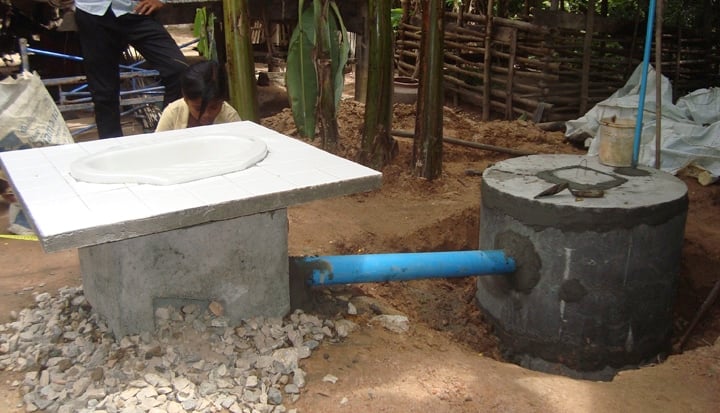The Problem and Context
iDE believes in the power of the market—the private sector—to improve lives and livelihoods. In the places that iDE works—rural areas of developing countries—the markets for many basic goods and services do not work; either they do not exist or they operate very ineffectively.
Historically, the “civil society sector” – that of nonprofits and NGOs – have largely employed a traditional charity model of giving away free goods and services, be it toilets, shoes, or healthcare. While this practice stems from good intentions, the efforts at best are insufficient to serve the immense scale of need, and at worst, detrimental to the vitality of local markets through distortionary effects of subsidy.
Easy Latrine Case Study
Prior to iDE’s intervention, very few private sectors were interested in producing and selling affordable, aspirational, and accessible sanitary latrines to the rural poor. Using the Human-Centered Design approach, iDE identified the unique needs, desires, and barriers of users and produced a product that households wanted to buy and businesses wanted to sell, creating a sustainable solution that can be scaled across the country.
Easy Latrine Design Process
The design effort followed a user-centered design methodology that began with in-field contextual observations and interviews with the key stakeholders involved in latrine manufacturing, installation and use. The learnings from the observations were distilled and synthesized into a framework that illustrated the potential opportunities for the design offering and showed where the design offering fit into the greater sanitation marketing effort.
From there, multiple rounds of brainstorming, prototyping and user testing were undertaken to develop the latrine designs. From the multiple iterations, a design direction emerged that addressed user needs as well as marketing thoughts around how to position the benefits and costs of latrine ownership.
User research phase
In the first phase of the project, iDE spent two weeks in the field talking with villagers, ring producers, retailers and masons to understand behaviors, needs and desires regarding latrines. All interviews and observations were performed in context—at the villager’s home, at the retailer’s store, and at the ring producer’s lot. Coming out of the user research, eight design principles were established to guide the work moving forward:
1. Let everyone go wet: Cambodians have an extremely strong preference for pour-flush latrines over dry pits.
2. Allow self-build at entry level: A simple do-it-yourself IKEA model will help lower costs.
3. Work from the bottom up: Focus on designing the underground, as that is the element that most users do have a clue about.
4. Reflect ‘in-progress’, not ‘temporary’: Position the latrine as upgradeable over time so users are not waiting to save for the most expensive model.
5. Divide the pit, slab & shelter (mentally): Doing so makes it seem easier and more manageable.
6. Set the stage for the mason: Reduce complexity and eliminate the need for expensive skills like laying bricks, but allow the mason to provide simpler, cheaper services such as mortaring the pieces together.
7. Show few options but enable many: Offer one simple underground to avoid paralysis by analysis, but allow users to customize the shelter according to their financial means and aesthetic preferences.
8. Support the shopping: Reduce the complexity of the purchasing process.
Prototype reviews
In the course of the design project, iDE took four trips to the field after the initial user research in order to review prototypes with stakeholders—villagers, masons, ring producers and retailers. In all cases, a number of 2D and 3D prototypes were shown.
Pilot Results
During the 16-month implementation phase of the pilot project, which was funded by USAID and technically supported by the Water and Sanitation Program (WSP) of the World Bank, 10,621 Easy Latrines were purchased by households without subsidy. The Easy Latrine served as a catalyst in the project to stimulate general interest of businesses to join the latrine market by seeing “proof of concept” of other businesses making a consistent profit from selling latrines to rural households. That is, the Easy Latrine was not the only latrine being sold. For every one Easy Latrine sold, 1.12 “other latrines” were also sold resulting in a total of 17,424 additional latrines purchased, increasing the baseline rate of latrine adoption by fourfold. A total of 24 local businesses were engaged during the project through training provided in the manufacture, promotion, and sales of the Easy Latrine. On average, the annual revenue of engaged businesses increased by 259%.
Scale-up results
Given the successful results of the Pilot Project, iDE secured funding from the Bill & Melinda Gates Foundation, the Stone Family Foundation, and the Water and Sanitation Program of the World Bank (WSP) to further scale up the market-based approach from the original two provinces to a total of seven provinces across Cambodia. In just over two and a half years, the scale-up program in Cambodia has facilitated the sale of over 100,000 latrines by over 100 local businesses, and creating a ripple effect of 1:1—for every latrine sold by an iDE-trained business, another latrine is sold by an “other” business, thereby having resulted in over 200,000 latrines just in the last 2.5 years, impacting the lives of over a million people.
The successful results of the Pilot Project in Cambodia also helped secure funding for sanitation market development efforts in five other countries—Bangladesh, Ethiopia, Nepal, Vietnam, and Zambia. Replicating process, not product, iDE used the HCD approach to design products and business models that are appropriate for the widely different contexts of the various locations.
Key takeaways
- Through the replication of a process, and not a business model, iDE is able to design solutions for market failures across different country contexts.
- The user includes not only the end-user, but all stakeholders who affect the user experience of the end user, i.e., all members of the value chain who would affect the user’s purchasing experience, from before the moment the user even considers to purchase, to after purchase maintenance.
- True innovation does not lie in the product alone. It is essential to get the product right, but the product serves as a catalyst for a thriving business model that serves the needs of both producers and consumers.
- Engagement with users at every step of the design process is key to effective rapid prototyping. You will never know if it will work until you test it out with the user.










